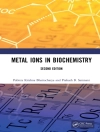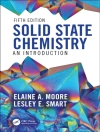This first book to focus on the applications of nanomagnetism presents those already realized while also suggesting bold ideas for further breakthroughs.
The first part is devoted to the concept of spin electronics and its use for data storage and magnetic sensing, while the second part concentrates on magnetic nanoparticles and their use in industrial environment, biological and medical applications. The third, more prospective part goes on to describe emerging applications related to spin current creation and manipulation, dynamics, spin waves and binary logic based on nano-scale magnetism.
With its unique choice of topics and authors, this will appeal to academic as well as corporate researchers in a wide range of disciplines from physics via materials science to engineering, chemistry and life science.
Innehållsförteckning
Part One Spin Electronics and Magnetic Sensing Applications 1
1 Introduction on Magnetic Sensing and Spin Electronics 3
Claude Fermon
1.1 Magnetic Fields 3
1.2 Magnetic Field Sensing 9
1.3 Introduction to Spin Electronics 12
1.4 Main Applications of Spin Electronics 13
2 Spin Electronics for Biomagnetism and Nuclear Magnetic Resonance 19
Myriam Pannetier Lecoeur, Reina Ayde, and Claude Fermon
2.1 Introduction 19
2.2 Biomagnetic Signals Detection with Spin Electronics Sensors 19
2.3 Nuclear Magnetic Resonance 24
2.4 Conclusion and Perspectives 35
References 35
3 Large-Volume Applications of Spin Electronics-Based Sensors 37
Paolo Campiglio and Claude Fermon
3.1 Introduction 37
3.2 General Concepts 38
3.3 Read Heads 42
3.4 Current Sensors 43
3.5 Angle and Compass Sensors 45
3.6 Speed Sensors 49
3.7 Switches and Position Sensors 52
3.8 Conclusion and Perspectives 53
References 53
4 Magnetic Random Access Memories 55
Sebastien Bandiera and Bernard Dieny
4.1 Introduction 55
4.2 MRAM General Principles 56
4.3 Field-induced Switching MRAM 58
4.4 Spin Transfer Torque Switching MRAM 62
4.5 Emerging MRAM Technologies 68
4.6 Conclusions 76
Acknowledgment 77
References 77
5 Spin Electronics for Non Destructive Testing 81
Matthias Pelkner and Marc Kreutzbruck
5.1 Introduction 81
5.2 Basic Concepts of Electromagnetic Testing Methods 82
5.3 GMR in MFL Testing 86
5.4 MR and Eddy Current Testing 94
5.5 Concluding Remarks 99
Acknowledgment 100
References 100
6 Diamond Spin Sensors: A New Way to Probe Nanomagnetism 103
Jean-Philippe Tetienne, Liam P. Mc Guinness, and Vincent Jacques
6.1 Introduction 103
6.2 Magnetic Sensing with Nitrogen Vacancy Defects in Diamond 104
6.3 Experimental Implementations for Sensing and Imaging 109
6.4 Applications 115
6.5 Conclusions 124
References 124
Part Two Magnetic Nanoparticles 127
7 Introduction to Magnetic Nanoparticles 129
Claude Fermon
7.1 Introduction 129
7.2 Main Properties of Magnetic Nanoparticles 129
7.3 Synthesis of Magnetic Nanoparticles 132
7.4 Main Classes of Applications of Magnetic Nanoparticles 132
7.4.5 Magnetic Particle Imaging 135
7.5 Conclusions and Perspectives 135
References 136
8 Use of Magnetic Nanoparticles in Biomedical Applications 137
Frank Wiekhorst and Lutz Trahms
8.1 Introduction 137
8.2 The Physics of Magnetic Nanoparticles Used in Biomedical Applications 138
8.3 Applied Nanotechnology: Biomedical Applications of MNP 142
8.4 Preparation of Magnetic Nanoparticles for Biomedical Applications 145
8.5 MNP Imaging in Biomedicine 147
8.6 Summary and Conclusions 158
References 159
9 Spintronic Biochips: From the Laboratory to Pre-Clinical Applications 165
P.P. Freitas, V.C. Martins, F.A. Cardoso, E. Fernandes, T. Sobrino, J. Castillo, A. Chicharo, M. Abal, R. Lopez-Lopez, T.S. Dias, and S. Cardoso
9.1 Introduction 165
9.2 Static Multiplexed Biosensors 166
9.3 Magnetoresistive Cytometers and the Detection of Rare Cells in Blood/Serum 185
9.4 Lateral Flow Magnetoresistive Biochips 193
9.5 Conclusions 194
Acknowledgment 194
References 196
Part Three Future Applications 201
10 Promising Prospects for Chiral Domain Walls and Magnetic Skyrmions as a New Way to Manipulate and Store Information 203
Stefania Pizinni and Vincent Cros
10.1 Introduction 203
10.2 Origin and Consequences of an Antisymmetric Exchange Interaction 204
10.3 Chiral Néel Walls in Systems with Perpendicular Magnetic Anisotropy and Dzyaloshinskii–Moriya Interaction 211
10.4 Magnetic Skyrmions in Noncrystalline Materials for Stabilization at Room Temperature 221
10.5 New Device Concepts Based on Chiral Magnetic Objects 228
10.6 Conclusions and Perspectives 235
Acknowledgments 236
References 236
11 Nanomagnetic Devices 239
Rolf Allenspach
11.1 Introduction 239
11.2 Memory and Storage-Class Memory 240
11.3 Logic Devices 247
11.4 Concluding Remarks 261
References 262
12 Microwave Nanomagnetism: Spin Torque Oscillators and Magnonics 269
Grégoire de Loubens and Matthieu Bailleul
12.1 Introduction 269
12.2 Basics of Magnetization Dynamics 269
12.3 Spin Torque Oscillators 272
12.4 Magnonics 282
12.5 Conclusions 290
References 291
13 Applications of Magnetic Oxides Thin Films and Nanostructures 297
Aurélie Solignac, Thomas Maroutian, and Philippe Lecoeur
13.1 Introduction 297
13.2 Magnetism of Oxides: Theory 299
13.3 Interest in Oxides: Strong Coupling Between Properties 307
13.4 Conclusions 314
References 314
Index 319
Om författaren
Claude Fermon is currently directing the Nanomagnetism and Oxide Laboratory in CEA, France. After an education at the Ecole Normale Superieure and in the University of Paris VI, France, he has obtained a Ph D in the field of nuclear magnetic resonance. His interest is focused on nanomagnetism, spin dynamics in nanometric objects, spin-dependent electronic transport in nanostructures, biomagnetism and spin electronics based magnetic sensors.
Dr. Claude Fermon has received a number of awards, among them the A. Abragam price for the development of neutron reflectivity methods and the A. Poirson price for the development of ultra-sensitive magnetic sensors. He has published more than 130 papers, one book, a number of book chapters and 22 patents.
Marcel Van de Voorde has 40 years` experience in European Research Organisations including CERN-Geneva, European Commission, with 10 years at the Max Planck Institute in Stuttgart, Germany. For many years, he was involved in research and research strategies, policy and management, especially in European research institutions. He holds a Professorship at the University of Technology in Delft, the Netherlands, as well as multiple visiting professorships in Europe and worldwide. He holds a doctor honoris causa and various honorary Professorships.
He is senator of the European Academy for Sciences and Arts, in Salzburg and Fellow of the World Academy for Sciences. He is a Fellow of various scientific societies and has been decorated by the Belgian King. He has authored of multiple scientific and technical publications and co-edited multiple books in the field of nanoscience and nanotechnology.












